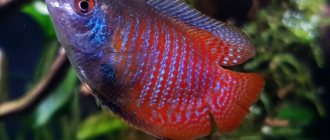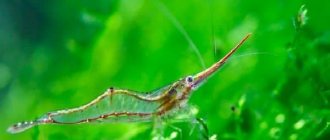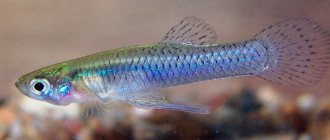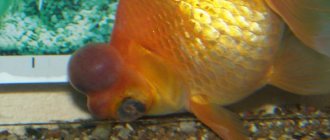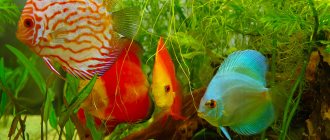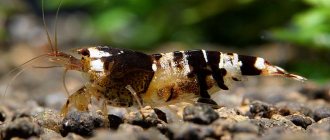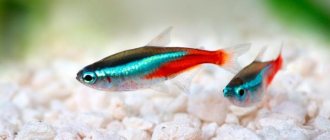The betta fish is a popular resident in the aquarium of beginners and professionals. If the former are attracted by the beauty of the bright veil fins of the fish and the unpretentiousness of keeping the betta fish, then the latter breed betta splendens to participate in special exhibitions and aquarium competitions. Still others train fighting fish for spectacular fights. The main thing is that cockerels have interesting behavior that is interesting to watch, just like the photo of a cockerel fish in an aquarium.
The article examines not only how to keep a betta and distinguish between male and female, but also introduces the varieties of the species and the history of the origin of Siamese fish.
| Full name | Siamese betta or betta fish. "Betta splendens" is Latin, English. – siamese fighting fish. |
| Kinds | Betta fish are a species of the genus Betta, represented by the Bett species: picta, striped, emerald, unimaculata and black dwarf betta. |
| Color | Red, yellow, white, black, blue, turquoise, purple. There are cockerels with double color, marbled, butterfly and dragon. |
| Water | Ph within 6-8. Hardness – 5-15. The temperature is chosen 24-28 degrees. |
| Feed | Flakes, floating granules and similar to insect larvae. |
| Compatibility | Intraspecific aggression towards male cockerels, sometimes towards spawning females. |
| Lifespan | Until the 3rd birthday. |
Habitat
The homeland of the cockerel is Southeast Asia. This is where inconspicuous natural forms live, which can be found in slowly flowing or stagnant bodies of water in Thailand, Cambodia, Laos, Vietnam, Indonesia and the Malay Peninsula. Bettas are found everywhere in the turbid, oxygen-poor waters of rice fields, and often even in the drains of large cities. An additional respiratory organ, the labyrinth, helps the cockerels survive in such extreme conditions.
Selected forms of cockerels have become real cosmopolitans. They can be found in hobbyist aquariums around the globe. Local and international exhibitions and competitions are held on a regular basis, where you can meet the most unusual and striking representatives of the aquarium betta.
General information
Betta fish belong to the suborder Labyrinth fish. Their peculiarity is the presence of a special respiratory organ called a labyrinth. This organ is represented by plates densely penetrated with blood vessels and is located in the accessory epibranchial plane. Thanks to it, bettas can use atmospheric air to breathe. This type of breathing is vital for aquarium bettas, so keeping them in a closed vessel, even well saturated with oxygen, leads to the death of the fish. The labyrinth appeared among cockerels as an adaptation to living in reservoirs poor in oxygen.
The betta is called a fighting fish because of its strong intraspecific aggression and territoriality.
Betta fish are extremely unfriendly with each other, and very often a collision between two males leads to the death of one of them. This feature has been used since ancient times by the residents of Thailand to conduct tournament fights for money. In some provinces this tradition is still alive.
Interesting training methods are used to prepare cockerels for tournaments. To increase stamina, the cockerel is placed in a tall bottle and forced to swim up and down for a long time. A mirror is moved along the glass, in which the betta can see its reflection. Creating a whirlpool in a round vessel also allows the cockerel to develop its strength. The fighting technique is perfected when the cockerel is placed with younger, weaker males.
Despite the ferocity of the clashes, “cockfights” are not without nobility. A male cockerel will never attack an opponent while he rises to the surface to swallow another portion of air. Also, if three males intersect in one place, the third does not interfere in the fight of the other two, but prefers to fight with the winner.
Appearance
The body shape of cockerels is oval, it is elongated in length and slightly flattened on the sides. Betta is a small fish. The average length is 5-6 cm, with females being smaller.
Male betta fish
The pectoral fins are pointed, while the dorsal and caudal fins are rounded. Male betta fish have more developed fins than females. Upper mouth. Natural coloration is usually dark brown with rows of shiny green spots, but in the aquarium the richness of color of these fish is unparalleled. The color of the scales of cockerels can change depending on environmental conditions: during spawning or skirmishes with other males, the color intensity increases, and during rest it weakens.
Modern breeders have bred more than 70 breeds of betta fish, differing in color and shape of fins. In aquariums you can find various variations of black, emerald, blue, red, pink and white tones. You can often observe how the scales of cockerels play and shimmer when moving and in bright light.
Color variations of betta fish
Depending on the shape and size of the fins, there are about ten varieties of aquarium bettas. For example, crown-tailed, delta-tailed, double-tailed and many others.
Origin
Southeast Asia is considered the birthplace of the betta fish. Its main habitats are warm, fresh, slow-flowing or stagnant bodies of water in Thailand, Vietnam, the Malay Peninsula and the islands of Indonesia.
The first mention of this unusual fish occurs in history in 1800. At that time, the inhabitants of Siam (now Thailand) noticed the increased aggressiveness of the males of this fish towards each other and began breeding a special breed for fights with monetary stakes.
Cockerels were introduced to Europe in 1892. The first countries to see the miracle fish were France and Germany. They came to the USA in 1910, where Frank Locke developed a new color version of the cockerels. In Russia, the history of their appearance is associated with the names of V.M. Desnitsky and V.S. Melnikov and date back to 1896.
Place
The Orion farm is seven hectares of area in a picturesque place in the Moscow region (Gorky direction). It’s easy to get to our estate; it is located on km 123 of the Gorky Highway.
The Moscow region is rich in beautiful places. The seven-hectare area of our estate is one of them. It offers quality family holidays. It is also a suitable place of rest for the solitude of an avid fisherman; lovers of Russian baths will also like it. The steam room on the property is excellent.
Do you want to fish in the morning or evening dawn? Are you planning a family vacation in the Moscow region? Are you going to meet friends outdoors? Come to the village of Starye Petushki. Recreation and fishing at Filipich are open to guests all year round.
Varieties
Selected species of Siamese cockerel can, first of all, be divided according to color into:
- Single color.
- Bicolor.
- Multicolor (multicolor). Usually the body is one color, and the fins shimmer in many shades.
The main classification of artificially created species is based on the variety of body shapes and fin sizes.
Veiltail
The veiled or veil-tailed cockerel (Betta Splendens VT) is the very first artificially bred type, which served as the basis for further breeding work. Body color is varied. It has a beautiful and large tail in the form of a veil.
Half Moon
The crescent cockerel has a large tail, the outer plumage of which forms a semicircle. The remaining fins are also abundant, large, and veil-shaped. The color is usually bicolor. There are several types of Betta splendens HM:
- The Halfsun (Betta Splendens CTHM) is the result of the hybridization of a common Crescent and a Crowntail.
- Feathertail - a tail in the form of a bunch of bright feathers.
- Rosetail (Betta Splendens RT) - the tail feathers are intertwined, forming as if rose petals.
Crowntail
Betta splendens CT or crown-tailed betta has a tail that resembles a royal crown. There are cockerels of this species with single, double and crossed rays.
Two-tailed cockerel
Betta splendens CT is distinguished by a tail fin that consists of two halves.
Roundtail
The round-tailed betta is very similar to the wild type of fighting fish, differing from it only in its rounded fins.
Speartail
The brush-tailed or spear-tailed betta (Betta splendens ST) has an original tail that looks like a spear or a bright brush.
Shorttail
The poster cockerel (Betta splendens PK) has a short and wide dorsal fin. There is also a separate species - the poster crowntail.
Delta
The delta-tailed betta (Betta splendens D) is similar to the veiltail. It is distinguished by a very hard caudal fin, forming a triangle when the fish moves. It looks like the Latin letter D, its outer rays form an angle of 130 degrees.
Superdelta
Betta splendens SD is distinguished by a tail angle of 130 to 180 degrees, an intermediate species between crescent and delta.
Giant
This variety is also called the royal or giant cockerel due to its large size, up to 8 cm. There are several types:
- poster giants;
- crescent;
- short-tailed;
- veiled giants.
The Dragon
The dragon fighting fish is not distinguished by the shape of its fins; their size is not important. This individual has a powerful, massive body with hard chainmail scales of a bright, often bicolor, color. For example, scarlet and white or graphite and turquoise.
elephant ear
Dumbo has a graceful body and massive fins of a characteristic shape.
Crest
The combtail or comb-tailed betta has tail feathers that resemble the teeth of a comb.
Price
Since there are many types of Siamese fighters, their prices differ. Simple crown-tailed and veiled-tailed specimens can be purchased for 190 rubles, although you can also find breeders who are willing to give the fish away for free. A female will cost even less - 130 rubles. Superdelta and elephant ear are more expensive - about 400-500 rubles. The cost of a cockerel with a crescent tail and a Cambodian dragon is 900-1000 rubles. Butterfly cockerel – 2000 rubles. Prices depend on the beauty and age of the fish. The more beautiful and rare the fish, the higher its price.
The most expensive Siamese fighting fish sold for $1,700 at an auction held on November 15, 2021.
She stood out because her color repeated the colors of the Thai flag - white, blue and red horizontal stripes. Other high-priced cases included a fancy copper white and red Betta that sold for $747, a white platinum dragon that sold for $680 and a Crescent Betta King Gold Dragon that sold for $570. The last two fish are distinguished by their uniform, delicate color and huge flowing fins.
Content
Nothing presents any difficulties, because... The aquarium fish is a tropical betta, it should be provided with an acceptable water temperature of 24–28 degrees, with a composition that does not have a high indicator. A house without a filter will not suit them.
Lack of sunlight can have a detrimental effect on development. A person’s task is to ensure that it enters the aquarium at least for several hours a day.
Air requirements
Fish cannot live without air. They need oxygen to breathe. To ensure that there is always enough supply, it is necessary to ensure that the surface of the water is clean. There should be no plants on it. If a film suddenly forms on the water, it must be removed. The cockerel is a fish that jumps well. For this reason, a lid is required. You can put on a net. At the same time, air must penetrate into the aquarium.
Water
To make the fish comfortable, only soft water is used. 1/3 of the fluid must be changed every week. If the tank is large, it is better to update the water once every 3 days. The fish are suitable for tap water that has been settled for two days. It is heated a little, it is necessary to remove the remaining food. If it is necessary to completely clean the aquarium, no chemicals are used. Cleaning is done with a dishwashing sponge; it removes dirt and algae from the surface well. You need to catch fish with a net. To make the fish comfortable, the following water parameters must be observed:
- Temperature - 24.5–28 degrees.
- Acidity is not that important, but 6–8 is acceptable.
- The minimum size of the aquarium is 5 liters.
- Hardness - 5–15.
Vegetation
It is acceptable to place artificial plantings; there is no arguing that it is much better to purchase live specimens. They make the tank look good. Fish use plants to create nests during spawning. Unpretentious plants: hornwort, cryptocoline, vallisneria and other simple plants.
Scenery
It is necessary to create an environment similar to natural conditions. Decorated with driftwood, stones, grottoes. The light should be dim. Filtration is necessary. It is necessary to fill the aquarium with water not to the very edge, you need to leave seven, ten centimeters, and cover with a lid. Atmospheric air is required. If there is no access to it, the fish may suffocate. The air swallowed by the bettas should not be too cold, so the aquarium is covered with a lid. Gravel or river sand is suitable for the soil.
Maintenance needs to be done regularly. It is necessary to wash the aquarium once a month, clean the soil from waste products of fish and snails. By maintaining normal water, acidity and cleanliness, your pet will live longer.
Feeding betta fish
The basis of nutrition for bettas in nature are aquatic insects and their larvae, zooplankton. Betta fish do not disdain individual algae. When kept in an aquarium, problems with feeding these fish usually do not arise. The best basic foods are complete dry foods from Tetra. The company's specialists have developed special food for betta fish that meets their nutritional needs - the Tetra Betta series:
- Tetra Betta is a high protein flake food thanks to the addition of shrimp and krill. Also contains natural enhancers of natural body color.
- Tetra Betta Granules are a balanced food for bettas and other labyrinths in the form of attractive floating granules. High protein levels, natural color enhancers ideal for bettas. The food contains a large amount of vitamins and nutrients that will help strengthen the immune system of your bettas.
- Tetra Betta LarvaSticks is a complete food in the form of granules that imitate insect larvae. The sticks are selected in such a way that it is convenient for the cockerels to swallow food. High digestibility improves water quality with regular feeding. Natural color enhancers make the body color of the fish bright and rich.
To add variety to the feeding process for bettas, you can use Tetra FreshDelica treats - popular food organisms in nutritious jelly, or Tetra FunTips Tablets - highly nutritious tablets that can be easily attached to the glass of the aquarium and allow you to observe with what pleasure the fish eat them.
Taking care of your health
The lifespan of these colorful “samurai” depends on care and maintenance.
Basic rules for home care, which have already been mentioned above:
- warm, settled water;
- the correct amount of water per individual;
- the presence of a filter, heater, compressor in the aquarium;
- regular water changes (partial);
- special feed.
With proper care, a betta fish can live for three years or even more.
How to distinguish a female from a male?
It is believed that females are smaller than males and inferior to them in the brightness of their color and the splendor of their fins.
However, you should not focus only on these signs. With high-quality nutrition and proper care, female cockerels can keep up with males in size. And during the spawning period they are distinguished by no less aggressiveness. sexual maturity by six months. At this time, males occupy a certain territory, often near islands of floating plants or in a corner, and begin to build foam nests. The male builds his house out of thin air.
The tireless builder constantly checks the nest for strength, adjusting the destroyed and scattered fragments, and catches up with the next aerial masonry. cockerels scare away competitors and actively flirt with the female, inviting her to see the future spawning ground. During spawning, males transform, their color becomes much brighter
While under the nest, the male embraces the female, wrapping his body around her. After spawning, the cockerel does not throw the eggs to the mercy of fate, but carefully collects them from the surface or bottom and places them in the center of the built nest. The female lays 200-300 eggs. After a week, the hatched fry disperse throughout the aquarium in search of food. The male guards his offspring for another 2-3 days.
Breeding
Like all labyrinth fish, bettas build their nest from a kind of foam that the males produce using their own saliva and water.
If it appears, it means preparations for spawning are underway.
Before spawning, the pair must be completely transferred to live food and placed in a special container with a small amount of water (up to 15 cm of water column). It should have a lot of dense plants so that the female can hide from the male attacking her. Java moss and duckweed work well for the surface. The water temperature is increased to +28 °C.
Within two weeks, the female increases greatly in size. Then the male wraps his fins around the female, squeezing eggs out of her (up to 50 eggs at a time) and at the same time processes the clutch with milt. During one spawning, a pair lays up to 200 eggs.
If the male has prepared the nest, but the female is not yet ready, he can beat her to death. In this case, they must be separated from each other by a glass partition.
After successful spawning, the female must be removed so that she does not get hurt and eat the eggs. Now the male will fiercely protect the clutch and take care of it - fanning it with his fins to saturate it with oxygen and remove dead elements, adding foam if it becomes scarce. If a lot of eggs drown, then the future father picks them up and transports them to the clutch. During this period, the lamp should be turned on around the clock so that the cockerel does not fall asleep and the offspring do not die by sinking to the bottom.
Disease Prevention
Due to the fact that the betta is a fighting fish, in confrontation with other relatives it can tear off its fins, but this does not mean that the fish is sick, so you should not grab different medicines and pour them alternately into the water. The disease can be determined by the behavior of the fish, especially if it changes gradually.
If betta aquarium fish are sick, their reproduction is not possible, since the individuals will simply not be able to perform their natural function. A sick individual should be immediately removed from the general aquarium so that others do not get sick, and only in a quarantine water space should the caught individual be treated.
It is worth remembering that sometimes treatment does not require expensive medicines for thousands of diseases, but just clean water and compliance with all its parameters, so you should never panic
Features of behavior
The strikingly beautiful appearance of the aquarium betta is in sharp dissonance with its fighting character. It is difficult to imagine that such a gentle creature, reminiscent of a water angel, is capable of fighting with its brothers for hours.
Males come into conflict with each other instantly and for any reason - because of a female, food, river. For this reason, you should not stock two male bettas in the aquarium.
Females are much calmer and usually treat each other friendly. But it is not always possible to predict their tempers.
The best combination for one pond is one male and a pair of females.
The male betta does not treat other inhabitants of the aquarium in the best way. Therefore, it is necessary to select neighbors for him extremely carefully.
The warlike temperament demands battles, even if there is no opponent nearby. Some of the more aggressive specimens can spend hours fighting with their reflection in the glass of the aquarium. But it is necessary to populate the pond with other fish; some of the species make the betta’s character much more peaceful and have a beneficial effect on the situation in the home pond. It's all about the right neighborhood.
Reproduction
Preparing the spawning tank: As a spawning tank, it is better to take an aquarium with a volume of 15 liters, pour 10 liters of water into it, be sure to cover it with a lid - the cockerels jump well. There should be shelter for the female, personally I use ceramic driftwood, floating plants - for me it’s usually pistia, you can add a few branches of nayas or hornwort. We put a heater in the spawning tank - the temperature should be about 26 degrees. You can place almond leaves in the spawning tank, for example - this is one of the spawning stimulants.
Spawning: Then you put the male there - usually he immediately builds a nest. The next day we place the female with him. Attention - the female must be plump, with eggs. The fish are not fed in the spawning area! Usually after 3 - 24 hours, spawning begins, during the process the male “embraces” the female and “squeezes” the eggs out of her, simultaneously fertilizing her.
Afterwards he releases the female, at this moment she is relaxed and practically goes to the bottom in the same position. The male is brightly colored, while the female, on the contrary, turns pale. In females of dark colors, dark longitudinal stripes may appear on the body. The male collects the falling eggs (they are sinking and white) into the nest and again “squeezes” the female, usually until there are no eggs left in her.
Next, the female hides, as the male begins to drive her away from the nest, because the female can eat the eggs. But it also happens that the female helps the male collect eggs in the nest. After spawning, the female should be removed.
Feed again: At this stage, you need to prepare food for the fry again, again preferably live - Artemia nauplii. You can buy brine shrimp eggs at a pet store or at Ptichka. I usually take a two-liter cola bottle, fill it with ¾ of water, put one and a half teaspoons of regular salt and a teaspoon of brine shrimp eggs, lower it with a spray from the compressor and place it on the aquarium rack, every other day the brine shrimp are hatched, the sprayer is turned off to collect, the crustaceans accumulate at bottom, and they are sucked in with a hose from the compressor. It is better to place 2 bottles with a difference of 2 days, then you will always have nauplii for feeding.
Caring for the offspring: Next, the male takes care of the nest - he eats dead eggs and renovates the nest. There is no need to feed him at this time, and there is no need to change the water either. After a day, the larvae begin to hatch.
At first they hang in the nest, the male continues to look after them, after a day their yolk sac usually dissolves and they begin to swim horizontally - at this moment you need to remove the male and turn on the compressor. Then the first feeding is done - we feed ciliates, if there are none, then you can feed them with food like Sera micron; I don’t recommend boiled egg yolk or boiled liver - they greatly spoil the water.
You need to feed so that there is always food in the aquarium. There is no need to change the water. Gradually, over the course of a week, the temperature in the aquarium should be reduced to room temperature. After 3 - 4 days, the fry begins to take artemia nauplii, but we do not stop feeding ciliates - the smaller fry still eat it. If there is no brine shrimp, you can feed both decapsulated brine shrimp and dry food like Sera micropan.
After a week or a week and a half, you can offer the fry frozen microplankton, and later - cyclops, cut tubifex. As soon as the fry begin to eat brine shrimp, you can gradually raise the water level, and later change the water. If you feed dry food - daily, if live - less often. When the fry reach a size of 1 cm, if you want to grow more fish, the fry need to be sorted into different aquariums, otherwise the larger fry will eat the smaller ones.
Then it is advisable to transfer the fish to a larger aquarium so that they do not drag on. When the fish begin to identify by sex and fight, you need to seat the males in separate containers, and it is better to feed the fish in them with live food. By the age of three months, cockerels are usually fully colored, with some exceptions; males begin to train in nest-building, and they can be placed for spawning at 4-5 months.
Caring for fry
The fry grow quickly and do not require much effort, you just need to follow some recommendations:
- in the first days, feed brine shrimp or ciliates.
- after 7 days you can already give specialized granulated food for fry or finely chopped tubifex;
- replace ¾ of the water in the aquarium daily;
- in 2-3 weeks it is advisable to sort large individuals from smaller ones;
- At the age of 4 weeks, the fry are transferred to a large aquarium.
Description of compatibility with certain fish species
Cockerels and guppies - it is believed that guppies and bettas live in water with different parameters, therefore they are only conditionally compatible. There have been examples of successful compatibility, but it’s not always worth the risk. Bettas can chase guppies throughout the aquarium until their fins are torn off. Guppies can live at temperatures of 18-28 degrees, although 22-25 degrees is a more tolerable temperature for them. The diet of both fish is the same, so some breeders did not have any difficulties in keeping them.
Angelfish and bettas - compatibility is not bad, provided there is a spacious tank. These fish practically ignore each other, without attracting attention to themselves. The cockerels would rather fight among themselves than bother the angelfish. However, during spawning, angelfish become more aggressive and can drive all their neighbors, including labyrinths. Provide plenty of cover and plants in the nursery to keep everyone safe.
Gourami - all species are close relatives of cockerels, so compatibility can be excellent. Gourami are curious creatures, tenacious and active, they also feed and breathe through gills and atmospheric oxygen. The cockerels do not bother them, sometimes the opposite happens. Place them together in a tank of at least 70 cubic liters. All Macropodidae have the same enemies: these are large and predatory fish, with which they should not be housed.
Mollies and bettas can live in an aquarium because they tolerate the same water parameters. But one fact is that mollies prefer slightly brackish water, but bettas do not. Temperatures of 24-27 degrees are optimal for keeping. At low temperatures, both fish begin to get sick. Mollies are viviparous fish that must breed in a separate spawning tank so that no one destroys their fry.
Botia are aggressive hydrobionts alone, so they can only be added to males in a flock of 4-7 fish. In the aquarium, bots are small, reaching only 8 cm in length. Peaceful, they can be kept with similar neighbors, provided there is space and shelter. Cockerels practically do not conflict with them.
Corydoras are suitable as neighbors for many fish. They have a calm disposition, interesting body color, and bring a lot of benefits. If the cockerel does not finish the food, the corridor will pick it up. Catfish swim at the bottom of the aquarium, bettas only sleep at the bottom. Compatibility between them has been proven; cockerels rarely bother Corydoras. Corydoras, like labyrinths, can use atmospheric air for breathing. Such a pet can survive under critical conditions. Catfish do not tolerate salt and organic matter well, just like bettas. The water in a community aquarium should be changed once a week.
Arrangement of the aquarium
The betta fish, the maintenance and care of which does not require much time and effort, is valued by aquarists for its ability to live even in small tanks. The ability of betta fish to breathe both with gills and air makes it possible not to install aeration in an artificial home pond.
Siamese cockerels are unpretentious aquatic inhabitants, but you will still have to pay attention to arranging housing for the fish. First, purchase an aquarium for the betta - it can be of any size, the main thing is that each individual has at least 5–7 liters of water. If the pond is wide, it is delimited by partitions - then it will be possible to have two males without fear of fights and quarrels. When thinking about how to set up an aquarium for a betta, you should not forget to purchase a lid or mesh for the pond so that the fish do not jump out.
Water parameters for a tank with a cockerel:
- hardness – from 4 to 15;
- acidity – from 6 to 7.5;
- water temperature – from 24C to 28C.
Renew the fluid regularly, replacing at least 30% of the volume. Remains of food are removed immediately after feeding to prevent contamination of the bottom. For preventive purposes, add table salt to the water (1 teaspoon per 6 liters).
Also, the aquarium for the betta fish is equipped with a thermometer and a heater to prevent overheating or hypothermia of the pets. Aeration is not important for fish, but a filter must be installed. It may be of small or medium power because the Betta does not welcome strong currents. The pond should not be placed under direct exposure to the sun.
Knowing how to care for Siamese fish, you can increase the lifespan of your bettas and enjoy the look of your aquarium for a long time.
Useful tips
You should not pet your bettas too often (although they allow it), as some owners do.
The scales have a protective layer of mucus on top. If this film is accidentally damaged, the fish will become very vulnerable to various diseases. Sometimes bettas can lie down on the bottom of the aquarium. If this does not last long, then there is no need to worry - this is how they rest. The alarm should be raised if this behavior has been observed for a long time. Then you need to contact a specialist and check the health of the fish.
If the fish are sick, there are special medications to treat them (antifungi or parasites, antibiotics). They can be purchased at a pet store.
We hope that this article was useful for those who are planning to place a betta fish in their aquarium. Let your pet feel comfortable and enjoy its beauty for a long time!

